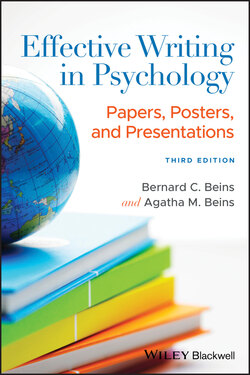Читать книгу Effective Writing in Psychology - Bernard C. Beins - Страница 41
Evaluating Sources
ОглавлениеWhether a source is popular, scholarly, primary, secondary, tertiary, or in the gray area between categories, it is vital that you consider the credibility of the information presented, specifically in relation to your research project. Many popular sources report scientific studies, and their reporting might be factually accurate but incomplete. Additionally, scientific studies, while likely to be credible, will be shaped by the authors' biases and assumptions. Thus, we encourage you to read all sources critically, even those that appear in academic journals and books. In the following sections, we outline some guidelines for evaluating sources you might encounter.
Much of the popular press is a for‐profit industry. Magazines and newspapers exist to make money. To a great extent, this objective shapes editors' decisions about what to include, what to exclude, and how to present what they publish. For this reason, there are popular print publications that focus on specific issues (such as Sports Illustrated and Rolling Stone) to increase sales. Additionally, publications target specific audiences. So, although the National Review and Mother Jones cover similar issues, the former generally targets a more conservative audience and the latter a more liberal one. Because of differing audiences, then, articles about the same topic might offer slightly different information or reveal different biases.
A for‐profit status also affects the way authors present information in an article. Editors want to catch the attention of readers, so they will place the most sensational or provocative information in the headline or first paragraph. This structure is called pyramid writing, and journalists use it because they know that most people won't read to the end of the article. If 100% of readers read the headline, about 70% will read the introductory paragraph, and only 50% will read through to the fourth paragraph (O'Connor, 2002, p. 117). Therefore, qualifications that some results do not reinforce a certain conclusion, or that more research is needed to confirm a hypothesis, may receive only brief mention and appear at the end of the article.
Because of the desire to provoke readers and sell more issues, popular sources can sometimes publish pseudoscience. What is pseudoscience? Etymologically, the word means “fake science”; however, it is not subject to a simple or easy definition. For example, you cannot merely state that real science is neutral and objective whereas pseudoscience is biased and subjective. Nor can you argue that real science always follows the scientific method, but that pseudoscience is sloppy. And you also cannot argue that pseudoscience results from a specific political agenda, and real science is separate from politics. So, what makes some studies “fake” and others “real”?
There are some guidelines you can use to determine whether a study is pseudoscience. In pseudoscience, as with science, you want to evaluate the content of a study and the publication in which the study appears. If you can determine that the study is published in a scholarly source, it is less likely to be pseudoscience.
A working knowledge of logical fallacies can also be useful for separating science from pseudoscience. The phrase logical fallacy describes a position that is logically untenable. If a writer uses unsound thinking to support a hypothesis, it can lead to an invalid conclusion. There are a number of different logical fallacies, but in Table 3.1 we describe only those more relevant to identifying pseudoscience. You can find a more detailed exploration of logical fallacies at: http://www.fallacyfiles.org.
Table 3.1 Logical Fallacies
| Fallacy | How It works | Example |
|---|---|---|
| Emotionally loaded terms | Appeals to a reader's emotions without using logic or other support to back up the argument | If you really cared about children, you would vote for the pro‐life candidate. |
| Bandwagon fallacy | Argues that, because everyone else thinks or acts a certain way, the reader should as well | The candidate won with a huge majority of votes, so she must be very qualified. |
| Faulty cause and effect | Sets up a cause–effect relation without evidence that the two events are causally related | As more homes have televisions, literacy rates have decreased; therefore, an increase in televisions causes a decrease in literacy rates. |
| Either/or reasoning (also a black and white fallacy or false dichotomy) | Presents a situation as having only two alternatives | Either aggression levels are biologically determined or they are caused by environmental factors. |
| Hasty generalization | Develops a conclusion or rule based on only an individual case or a few cases | This study shows that college students scored well on the test; therefore all 18‐ to 21‐year‐olds would score well. |
The presence of a logical fallacy does not necessarily invalidate all the work done in a study; however, fallacies are warning signs that there might be other weaknesses in the research. Additional items to look for when evaluating a source's credibility are unexplained or unacknowledged contradictions, persuasion with creative or strong language rather than valid evidence, the presence of jargon that other scientists do not use, and the lack of reliable sources that support the hypothesis and conclusion.
For scholarly examinations of pseudoscience, see Pigliucci (2010), Leahy (1983), Lilenfeld, Lohr, and Morier (2001), Still and Dryden (2004), Olatunji, Parker, and Lohr (2005/2006). There are also websites that explore various kinds of pseudoscience. Some examples are:
https://surface.syr.edu/suscholar/vol4/iss1/2
http://www.quackwatch.org/01QuackeryRelatedTopics/pseudo.html
http://www.softpanorama.org/Skeptics/index.shtml
https://www.scientificamerican.com/article/what‐is‐pseudoscience
https://www.thegreatcoursesdaily.com/what‐is‐pseudoscience‐learning‐to‐objectively‐evaluate‐science
